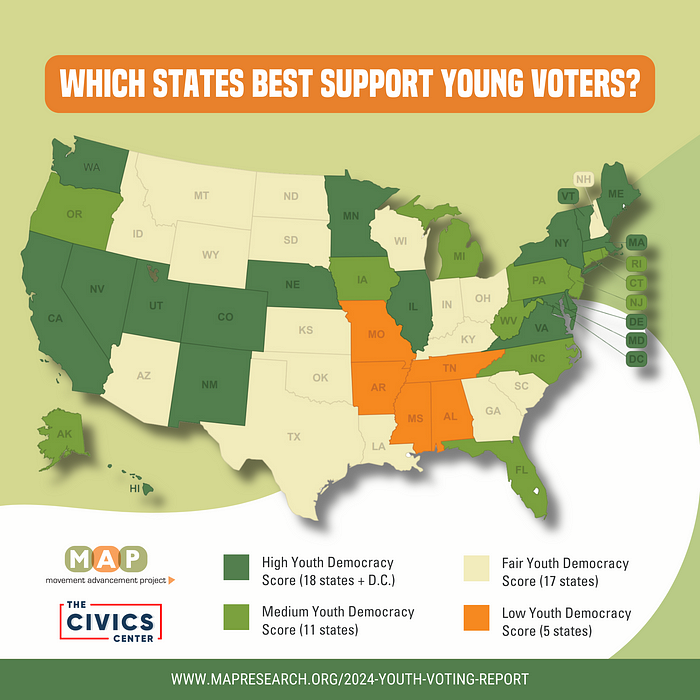Democracy Maps
How States Can Empower Young Voters and Remove Barriers to the Ballot

In a Q&A with Brian Hinkle, MAP’s Senior Voting Policy Researcher, we discuss our new Democracy Maps report, which details the power of the youth vote in 2024 and policies states can adopt to support young voters.
The youth vote is projected to have a significant impact on 2024’s elections. Young voters are prominent and powerful by the numbers; yet long-standing structural barriers and ongoing political attacks continue to disenfranchise young voters and limit their access to the ballot.
As the presidential race speeds up, we had a conversation with Brian Hinkle, MAP’s Senior Voting Policy Researcher and author of our new report, A Silenced Generation: How the Power of the Youth Vote Collides with Barriers to Voting, in partnership with the The Civics Center.
In this Q&A, Brian offers top-line findings from MAP’s latest analysis and explains what states can do to support young voters in 2024 and the years ahead.
MAP: Can you describe the power of the youth vote in 2024?
Brian Hinkle: More than eight million members of Gen Z have become eligible to vote since the 2022 election cycle. When including voters under the age of 30, the total young voter demographic comprises over 50 million potential voters.
Young voters are also incredibly diverse: of the 40 million eligible Gen Z voters in 2024, 45% are people of color, and among the estimated 8 million newly eligible voters, that percentage is even higher. Over 21% — one in five — Gen Z adults identify as LGBTQ, roughly three times higher than the same number for all adults in the United States.
The sheer size and increasing diversity of young voters makes them perhaps the most important demographic in the 2024 elections. And soon, these voters will have the numbers to exert their influence on the future of our democracy.
How does the youth vote impact the health of our democracy?
BH: It may seem obvious, but these voters truly represent the future of our country — and it is their future on the line. They will have the most important say as to whether our democracy will represent the growing diversity of all Americans.
In recent years the country has seen a record amount of anti-LGBTQ legislation, attacks on abortion access, increasing censorship, and growing rejection of the core tenets of democracy. In this crucial moment, young voters have the opportunity to create a more representative democracy, where people of color, LGBTQ people, and other historically underrepresented populations have their voices heard rather than silenced.
It’s critical to engage these young voters now to create a generation that is poised to participate in all aspects of civic life, including voting, both now and in the long term. Research shows that voting is a habit that is established at a young age, particularly for first time voters, and people who vote are more likely to engage in other forms of political participation such as contacting their elected officials or working on a campaign.
Do states vary in terms of their support for young voters?
BH: Yes. The landscape of electoral environments for young voters varies widely from state to state.
Our youth voting report includes a brand-new metric, the Youth Democracy Score, which analyzes 11 key policies that particularly impact young voters. This ranking helps us understand which states are providing robust youth voter environments and those that are not.

It’s important to note that nearly one in 10 young voters live in a state with low Youth Democracy Scores, and almost one-third of young voters live in states that rank in the second lowest category of Youth Democracy Scores.
Additionally, states that score in the low or fair category in our scoring also tend to fall among the states with the lowest rates of turnout among young voters.
How does voter turnout among young voters compare to older voters?
BH: Historically, young voters have turned out to vote at lower rates than older voters, but fortunately, that gap is closing. We see this very clearly in turnout data across decades of presidential elections, as shown in our new report.

The difference in voter turnout is often attributed simply to apathy or generational differences on the part of young voters, but these don’t reflect the true picture. Our latest report highlights how young voters face a series of structural and intentional barriers to participating in the democratic process. Even when young voters are enthusiastic and prepared to vote, a shocking number of obstacles can stand in their way.
What are some of these barriers to participating in our voting and election system?
BH: First, young voters’ lack of voting experience can create an information gap. If a young person has never voted before, they are less familiar with registration requirements, how and where to submit registration paperwork, and the required ID or documents they will need. Especially in a complex landscape of voting laws across the country, it’s not easy to be familiar with the requirements to vote in a given state, especially for first-time voters.
Young people also move more frequently, which presents challenges with voter registration and casting a ballot. Each time a person moves, they need to update their registration to match their new location, or otherwise risk being turned away at the polling place. While these all may seem like simple tasks, the stress and logistics of moving can make it easy for people to forget this step until the next time they go to vote, at which point it may be too late.
Most importantly, a growing number of states have taken action to restrict voting for young people through voter registration and residency limitations, restricting availability of early voting and polling locations, and restrictive voter identification requirements.
We know that strict voter ID requirements depress turnout generally — and may especially impact young voters, who are less likely to have a driver’s license, and can have a particular impact on young voters who are people of color or transgender.
Young voters also tend to work unpredictable schedules at hourly jobs where they may be forced to choose between wages and voting. Without access to early voting, ballot drop boxes, and same-day voter registration, opportunities to vote can be limited, especially among young voters. Data from 2022 shows that more than half of young voters cast their ballots before Election Day, which points to the real outcomes of policy solutions that enable young voter access.
Can states remove barriers for young voters? If so, how?
BH: Absolutely, a range of policies related to voter registration, in-person voting, mail voting, and civic engagement can respond to and address the structural and intentional barriers that young voters face.
Voter registration policies are arguably the most important areas that can be addressed in terms of lowering the barriers for youth participation. Pre-registration, automatic registration, online registration and same-day registration policies have all been shown to have significant impacts on registration and turnout rates among young voters.
Pre-registration alleviates barriers by allowing eligible people as young as 16 to sign up to be automatically registered to vote once they turn 18. Currently, 20 states and D.C. allow pre-registration at age 16, and an additional four states allow pre-registration at age 17. Registering earlier also offers young voters a chance to become engaged in the election system and learn about voting processes before they become eligible.
Same-day voter registration also increases access to voting and boosts voter turnout, especially among young voters. Election Day registration can provide a fail-safe for young voters who are unable to register in advance. For example, if a young voter recently moved and didn’t know that they needed to update their voter registration to their new address, they would still be eligible to register up until Election Day in 22 states and D.C.
Automatic voter registration (AVR) is a policy that can reduce barriers for younger voters. By automatically enrolling voters through interactions with designated state agencies, like DMVs, AVR helps to make sure that every eligible voter has access to vote. Research conducted in Oregon suggests that AVR contributed to an increase in turnout among young voters in the state, and according to new research from Next-Gen in Colorado, the combination of AVR and voter pre-registration policies have an especially powerful impact on the rates of registration for young voters.
States should also adopt policies that reduce barriers to voters actually casting their ballots once they are registered. States need to reform their ID policies, increase accessibility of early voting and polling locations, allow young people to vote in primaries, offer options for absentee and mail voting, and require employers to provide paid time off to vote.
There are many clear and effective ways that policymakers and other stakeholders in our democracy can take on the challenge of supporting these young voters. To make this vision a reality, states must engage young voters now, as well as create an environment that is conducive to forming a culture of strong civic engagement and democracy.

